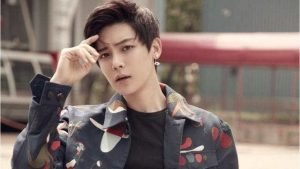The Lost Tomb 2 : Explore with the Note Episode 4 Recap
> The Lost Tomb 2 : Explore with the Note Recap
Wu Xie, having just discovered a basin-like coffin from the Warring States Period, questioned whether the tomb they were in belonged to the Ming Dynasty or the Warring States. He recalled the Seven Star Lu King Palace, another tomb from the Warring States Period, and noted that snake-browed copper fish were found in both, making him wonder about their connection. His confusion deepened when he found a porcelain jar depicting officials in Ming dynasty uniforms inspecting a construction project.
A strange sound from the water preceded Wang Pangzi and Zhang Qiling emerging from below. Wu Xie immediately noticed a black mark on Zhang Qiling's arm. Zhang Qiling explained it was from a white-haired Drought Demon that had pulled him. Wang Pangzi asked why he hadn't killed the creature. Zhang Qiling clarified that beheading it would release large amounts of ptomaine, and given their limited oxygen, it wasn't a practical course of action.
Wu Xie then acknowledged his previous analysis about an elevator-like mechanism being incorrect, a fact Wang Pangzi confirmed they had already deduced from the looting hole they had used. Wu Xie presented the porcelain jar, pointing out the Ming dynasty official uniform. He theorized that the tomb owner was either a noble or a highly respected architect from the early Ming Dynasty, skilled in feng shui and geomancy, capable of constructing such an elaborate underwater tomb.
He identified Wang Zang Hai, famous for designing the Ming Imperial Palace and several major cities, as the most probable architect. Wu Xie speculated that the pond served as an exit, noting that the looting hole connected to it and another under the coffin, suggesting the original tunnel driller was quite unlucky. As the water in the pond receded, the group saw a staircase and a monument in the distance.
Descending the dark and foggy stairs, Wang Pangzi spotted carvings on the wall, specifically English acronyms. Wu Xie speculated that they were carved urgently by an archeological team member 20 to 30 years ago, not a foreigner, as Chinese characters are more difficult to carve quickly. Wu Xie expressed concern about the water level rising again and suggested going back up due to the danger of being caught by a sudden surge, but Wang Pangzi dismissed his worries.
Zhang Qiling, after intently studying the English carvings, announced that he believed he had been there before. He then walked further into the water without explanation, ignoring Wu Xie and Wang Pangzi's calls. As they followed, Zhang Qiling warned them about hidden holes beneath the water after Wang Pangzi accidentally stepped into one. Zhang Qiling paused in front of a Sea-calming monkey statue. Wang Pangzi asked Wu Xie to translate the inscription on the accompanying monument.
Wu Xie read that the tomb owner had constructed a Heavenly Palace, and its entrance was concealed within the stone monument, accessible only to the "right person." Wu Xie interpreted this as an allegory, suggesting the palace and its door were metaphors, but confirming a hidden secret. Wang Pangzi discovered old diving equipment, prompting Wu Xie to question if previous explorers had genuinely entered the Heavenly Palace through the monument.
Concerned about rising water levels, Wu Xie urged them to go back up, especially after hearing another strange sound from the water. They realized Zhang Qiling had moved away and found him standing motionless in front of the monument. When asked what was wrong, Zhang Qiling simply repeated, "I think I had been here before."
Zhang Qiling's memories then vividly resurfaced, transporting him back to a previous expedition in the underwater tomb with Wu Sansheng and other archeological team members, including Wen Jin, Huo Ling, Zhou Yuan, and Xu Qiang. In a side chamber, Wu Sansheng was asleep, and Wen Jin ensured he remained undisturbed. The team discovered unique symbols on the bases of porcelain artifacts. Two team members debated their meaning—whether they were Ming porcelain markings or identity inscriptions.
Zhang Qiling was asked to examine them. Wu Xie, in the present, added that he too had noticed these symbols earlier, realizing they were not mere decorations but a systematic coding, and that the paintings on the porcelains, some depicting a "palace in the heaven" or a Taoist priest, must hold a significant purpose.
He recalled the legend of Zhu Yuanzhang commissioning Wang Zang Hai to build an extraordinary palace, which Wang Zang Hai allegedly accomplished by creating a magnificent illusion of a Heavenly Palace using a giant kite. Wu Xie then pressed Zhang Qiling to continue his recollection of events. Believing more clues lay within the coffin in the rear hall, Zhang Qiling proposed they continue their exploration.
Wen Jin initially resisted, arguing that they shouldn't proceed without Wu Sansheng, who was exhausted and sleeping. However, Zhang Qiling asserted his ability to manage, and with the rest of the team agreeing to follow, Wen Jin conceded. They collectively decided against waking Wu Sansheng, fearing he would argue with Zhang Qiling, and resolved to return as quickly as possible, leaving him behind to sleep. The group reached the Sea-calming monkey statue, a place Zhang Qiling seemed particularly drawn to.
While some of the team initially mistook illusions caused by metal particles in the fog for monsters, Wen Jin assured them that the tomb's good feng shui prevented such entities. As they prepared to leave, Zhang Qiling stood motionless atop the statue, staring intently. Wen Jin approached him, but he indicated for her to look ahead. To their shock, they saw Wu Sansheng, seemingly in a trance, combing his hair in a mirror.
Huo Ling attempted to intervene, but Wu Sansheng violently pushed her aside before fleeing into a hidden door. The stone door then abruptly closed behind him. Zhang Qiling observed that behind the closed door, another layer of wall was slowly rotating. Zhang Qiling elaborated that the entire pond was a massive trap, and behind the closed door, another wall was slowly rotating.
He theorized that the mechanism operated on the simplest principles, likely harnessing the movement of the tides to ensure its longevity. He then revealed he had found eight such trapdoors. Wu Xie identified this complex system as "Qimen Dunjia," also known as the "Eight Formations," a military strategy and numerology study with a long history.
He explained that Qimen Dunjia consisted of eight gates: prosperity, pleasure, life, death, fright, injury, shelter, and visionary, with only the "Life Gate" offering a safe passage, while the "Death Gates" led to demise or other cycles of eight gates. Wang Pangzi, frustrated, demanded to know which door was the exit, but Wu Xie admitted he couldn't tell, as the constant rotation of the walls made it impossible to discern the Life Gate from the Death Gates.
Wang Pangzi, seeking answers, turned to Zhang Qiling. Zhang Qiling recalled that Wen Jin had deduced the true meaning of Wu Sansheng's actions. He hadn't been combing his hair; instead, by touching his sideburns while looking in the mirror, he was subtly adjusting the angle and height of a hidden mechanism within the monument. This mechanism, which moved in sync with the rotating wall, would point to the "Life Gate," or the true exit.
Following this revelation, the group entered through the indicated Life Gate, leading them into a pathway towards what was described as the "Cloud-Top Heavenly Palace." During their journey through the channel, Wen Jin experienced a strange sensation of something touching her neck, though she saw nothing upon looking.
Finally, they arrived at the Cloud-Top Heavenly Palace, a magnificent and opulent sight that left the entire team in awe, captivated by its grandeur, the Phoebe Zhennan logs, and the luminous pearls adorning it.




















